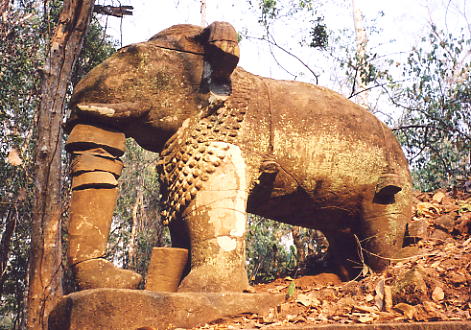
ANDYBROUWER.CO.UK
CAMBODIA TALES 2005 - JANUARY
Koh Ker uncovered
The GST Express bus ticket to
Phnom Penh costs $3. Its one of a number of bus companies that
ply the route and is favoured by locals. I was only travelling as
far as Kompong Thom, which is less than half-way, but the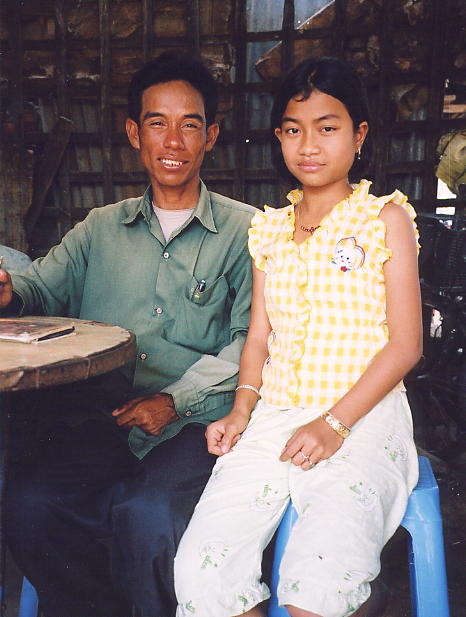 price is still the same. We left the bus station,
located at the far eastern end of Siem Reap town, a little after
8am, but not before I swapped seats with a young girl who looked
horrified when she realised her seat was next to a monk.
Culturally, women shouldn't touch monks so to alleviate the
situation, I offered to exchange seats. The young monk spoke
pretty good English and we chatted for a while during the two
hour ride to Kompong Thom. I had called and spoken
price is still the same. We left the bus station,
located at the far eastern end of Siem Reap town, a little after
8am, but not before I swapped seats with a young girl who looked
horrified when she realised her seat was next to a monk.
Culturally, women shouldn't touch monks so to alleviate the
situation, I offered to exchange seats. The young monk spoke
pretty good English and we chatted for a while during the two
hour ride to Kompong Thom. I had called and spoken 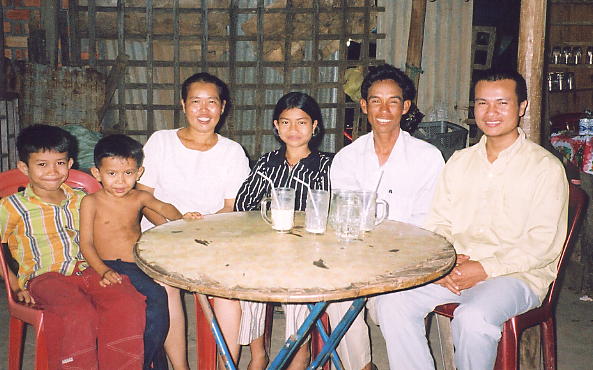 to Sokhom's wife the
night before, so I knew that my pal was on his way back from a
trip to Preah Khan with another traveller, so the rest of my day
would be a relaxed one. As I stepped off the bus, a couple of the
waiting moto-drivers recognised me and vice versa, from my
frequent visits to their hometown. One of them, Sarom, confirmed
that 'Mr Sokhom' wasn't back yet, so I paid a flying visit to
Sokhom's home to see his wife and daughter before checking into
the Mittapheap hotel ($10 air-con). Dumping my bags, I jumped on
Sarom's moto for an hour's leisurely drive around town and along
the Stung Sen riverbank before returning to the hotel for a
siesta. Sokhom knocked on my door at 12.30pm and it was back to
his home for a reunion lunch with his family. He was tired
to Sokhom's wife the
night before, so I knew that my pal was on his way back from a
trip to Preah Khan with another traveller, so the rest of my day
would be a relaxed one. As I stepped off the bus, a couple of the
waiting moto-drivers recognised me and vice versa, from my
frequent visits to their hometown. One of them, Sarom, confirmed
that 'Mr Sokhom' wasn't back yet, so I paid a flying visit to
Sokhom's home to see his wife and daughter before checking into
the Mittapheap hotel ($10 air-con). Dumping my bags, I jumped on
Sarom's moto for an hour's leisurely drive around town and along
the Stung Sen riverbank before returning to the hotel for a
siesta. Sokhom knocked on my door at 12.30pm and it was back to
his home for a reunion lunch with his family. He was tired 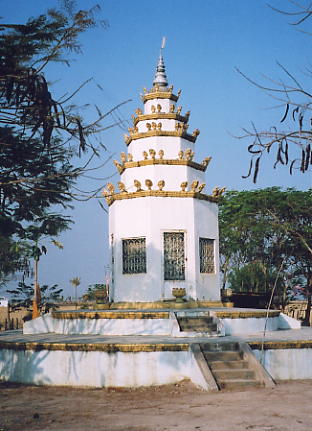 from his travels so we
briefly discussed my plans to head for Koh Ker first thing the
next morning and then onto Preah Vihear, before I left to use the
internet at the nearby Buddhist Development Institute office,
where I met the local female reporter for the Cambodia Thmey
Daily newspaper. The cost of internet access at 3,500 riel for
the hour was almost double the price of the Siem Reap equivalent.
At 7pm, Sokhom collected me from the hotel and delivered me to
the Bayon restaurant, tucked away behind the market area, where
his wife Sroy and adorable daughter Kunthea, together with his
young nephew, Sal were already waiting. This was my treat and a
timely return to the Bayon, where we'd dined previously. Our
table was on the pavement, the restaurant was full and the food
was delicious, rounded off with tikaloks outside Sokhom's home
before I retired to bed just before 10pm. Its always a genuine
pleasure to spend time with my friend and his family and a meal
on my first night back in Kompong Thom was a perfect motive.
from his travels so we
briefly discussed my plans to head for Koh Ker first thing the
next morning and then onto Preah Vihear, before I left to use the
internet at the nearby Buddhist Development Institute office,
where I met the local female reporter for the Cambodia Thmey
Daily newspaper. The cost of internet access at 3,500 riel for
the hour was almost double the price of the Siem Reap equivalent.
At 7pm, Sokhom collected me from the hotel and delivered me to
the Bayon restaurant, tucked away behind the market area, where
his wife Sroy and adorable daughter Kunthea, together with his
young nephew, Sal were already waiting. This was my treat and a
timely return to the Bayon, where we'd dined previously. Our
table was on the pavement, the restaurant was full and the food
was delicious, rounded off with tikaloks outside Sokhom's home
before I retired to bed just before 10pm. Its always a genuine
pleasure to spend time with my friend and his family and a meal
on my first night back in Kompong Thom was a perfect motive.
We were on the road at 7.30am
the next day, heading for the temple complex of Koh Ker, with
Sokhom 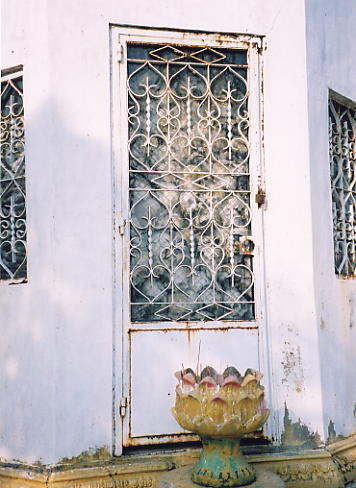 surprising me by
taking Route 6 towards Siem Reap rather than going north to Tbeng
Meanchey. He's a regular visitor to these northern temples so I
trust his judgement implicitly and he felt that Route 6 and the
new road to Koh Ker via Beng Mealea would be the quicker option.
All along the main highway, we got a mixture of surprised looks
and happy waves as most tourists whizz past at breakneck speeds
inside cars or buses rather than sat on the back of a moto. After
an hour we reached the town of Stoung and on the outskirts, off
to the right and in the grounds of a small wat, Tuol Ta Phlorng,
we visited a genocide memorial stupa containing the bones and
skulls of victims uncovered in mass graves nearby. Its believed
over 100,000 victims perished in the immediate area at the hands
of the Khmer Rouge. We paused briefly at Spean Praptos after
surprising me by
taking Route 6 towards Siem Reap rather than going north to Tbeng
Meanchey. He's a regular visitor to these northern temples so I
trust his judgement implicitly and he felt that Route 6 and the
new road to Koh Ker via Beng Mealea would be the quicker option.
All along the main highway, we got a mixture of surprised looks
and happy waves as most tourists whizz past at breakneck speeds
inside cars or buses rather than sat on the back of a moto. After
an hour we reached the town of Stoung and on the outskirts, off
to the right and in the grounds of a small wat, Tuol Ta Phlorng,
we visited a genocide memorial stupa containing the bones and
skulls of victims uncovered in mass graves nearby. Its believed
over 100,000 victims perished in the immediate area at the hands
of the Khmer Rouge. We paused briefly at Spean Praptos after 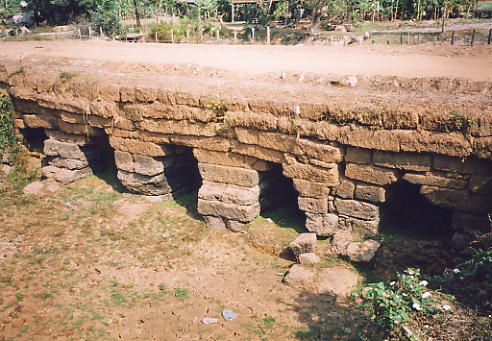 another hour before breaking our journey at Damdek
at 10am, stopping at a roadside stall near the market for a
chicken and rice breakfast. Whilst Route 6 is now in excellent
condition, the road from Damdek to Beng Mealea was being widened
and as a result, the red dust cloud kicked up by passing lorries
was choking though fortunately for us the traffic was light. The
checkpoint booth just before Beng Mealea - it should cost $10 to
visit Koh Ker - was negotiated by Sokhom with a smile and a
promise to pay the charge when we arrived at Koh Ker, and this
satisfied the official in charge. As it turned out, we never saw
another official and so our trip to Koh Ker was a freebie. We
reached Svay Leu at mid-day and carried on along the brand new
road, beautifully smooth in places with very few inhabitants
living amongst the smouldering forest areas and two sprawling
army camps. It took us an hour to reach Siyong village, some
eight kilometres from Koh Ker, and a kilometre off the main road.
We called into the village and the wooden KohKe guesthouse,
standing on tall stilts at the end of the main street, for a
welcome wash and brush-up after our five hours on the road.
another hour before breaking our journey at Damdek
at 10am, stopping at a roadside stall near the market for a
chicken and rice breakfast. Whilst Route 6 is now in excellent
condition, the road from Damdek to Beng Mealea was being widened
and as a result, the red dust cloud kicked up by passing lorries
was choking though fortunately for us the traffic was light. The
checkpoint booth just before Beng Mealea - it should cost $10 to
visit Koh Ker - was negotiated by Sokhom with a smile and a
promise to pay the charge when we arrived at Koh Ker, and this
satisfied the official in charge. As it turned out, we never saw
another official and so our trip to Koh Ker was a freebie. We
reached Svay Leu at mid-day and carried on along the brand new
road, beautifully smooth in places with very few inhabitants
living amongst the smouldering forest areas and two sprawling
army camps. It took us an hour to reach Siyong village, some
eight kilometres from Koh Ker, and a kilometre off the main road.
We called into the village and the wooden KohKe guesthouse,
standing on tall stilts at the end of the main street, for a
welcome wash and brush-up after our five hours on the road.
Just after 2pm, feeling
refreshed, we rejoined the new road to take us to the complex of
temples known as Koh Ker, a royal city built by Jayavarman IV in
the tenth century, and where new temples and secrets are
uncovered every dry season when more of the surrounding area is
demined. This was my third visit and was 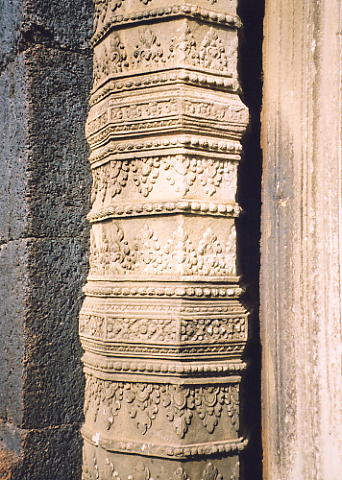 considerably easier
than the gruelling trips I'd made previously. No longer is it
necessary to wind your way through uninhabited forests and across
rough terrain via a single oxcart track, or no trail at all,
instead the new road brings you to the first of the temples,
Prasat Pram, in less than twenty minutes from Siyong. Since my
last visit in December 2003, Prasat Pram has been cleared of
vegetation and tidied up. There are still landmine signs in the
vicinity but less obvious than before and the temple, with three
brick towers and two libraries engulfed by trees and surrounded
by a laterite wall, is a pleasant introduction to the royal city.
A noticeable addition was a sign in Khmer with the temple name on
it, pointing west along a forest track towards the structure.
Continuing along the new road, we came to Prasat Neang Khmau on
our right-hand side and more landmine signs, which were located
exactly where, on my previous visits, I'd walked through the the
undergrowth to visit this temple! The single laterite tower which
unusually opens out to the west and is enclosed by a wall, has a
'burnt' look on its walls and contrary to popular belief that its
the result of setting fire to nearby weeds and brush, its
actually a result of the iron-based laterite rock oxidizing (or
rusting) and
considerably easier
than the gruelling trips I'd made previously. No longer is it
necessary to wind your way through uninhabited forests and across
rough terrain via a single oxcart track, or no trail at all,
instead the new road brings you to the first of the temples,
Prasat Pram, in less than twenty minutes from Siyong. Since my
last visit in December 2003, Prasat Pram has been cleared of
vegetation and tidied up. There are still landmine signs in the
vicinity but less obvious than before and the temple, with three
brick towers and two libraries engulfed by trees and surrounded
by a laterite wall, is a pleasant introduction to the royal city.
A noticeable addition was a sign in Khmer with the temple name on
it, pointing west along a forest track towards the structure.
Continuing along the new road, we came to Prasat Neang Khmau on
our right-hand side and more landmine signs, which were located
exactly where, on my previous visits, I'd walked through the the
undergrowth to visit this temple! The single laterite tower which
unusually opens out to the west and is enclosed by a wall, has a
'burnt' look on its walls and contrary to popular belief that its
the result of setting fire to nearby weeds and brush, its
actually a result of the iron-based laterite rock oxidizing (or
rusting) and 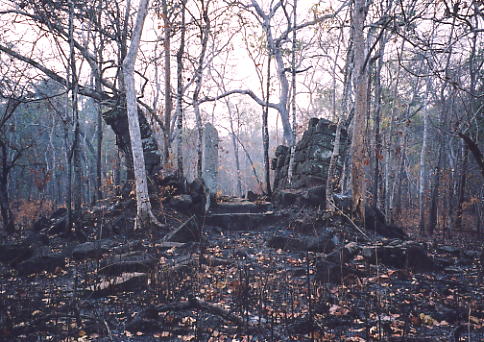 causing it to darken. I
must also mention the lively lintel showing Brahma that is still
in situ above the entrance. A little further on and a few metres
from the road, Prasat Bak (bak = broken) is a tiny laterite
temple that looks as if its been split in half by a thunderbolt,
though a sign erroneously calls the temple Prasat Damrei, as the
temple was originally dedicated to Ganesha. About 100 metres
further into the forest stands the much more imposing Prasat
Chen, a temple I tried to gain access to on my first ever visit
in 2001, but failed because of the dense undergrowth at the time.
Now mostly cleared, Prasat Chen has two enclosure walls of
laterite and three massive laterite towers covered in foliage and
flanked by two broken brick libraries. Much of this
once-impressive temple is in ruin, including the brick gopura of
the outer enclosure, damaged lintels, colonettes and part of an
inscription stone (which glorifies Vishnu), in ancient Sanskrit
script, lying near the entrance. The legacy of Koh Ker is that
its sculptures and monuments are on a massive scale and this
includes two fighting apes found at Prasat Chen and now on
display at the National Museum in Phnom Penh.
causing it to darken. I
must also mention the lively lintel showing Brahma that is still
in situ above the entrance. A little further on and a few metres
from the road, Prasat Bak (bak = broken) is a tiny laterite
temple that looks as if its been split in half by a thunderbolt,
though a sign erroneously calls the temple Prasat Damrei, as the
temple was originally dedicated to Ganesha. About 100 metres
further into the forest stands the much more imposing Prasat
Chen, a temple I tried to gain access to on my first ever visit
in 2001, but failed because of the dense undergrowth at the time.
Now mostly cleared, Prasat Chen has two enclosure walls of
laterite and three massive laterite towers covered in foliage and
flanked by two broken brick libraries. Much of this
once-impressive temple is in ruin, including the brick gopura of
the outer enclosure, damaged lintels, colonettes and part of an
inscription stone (which glorifies Vishnu), in ancient Sanskrit
script, lying near the entrance. The legacy of Koh Ker is that
its sculptures and monuments are on a massive scale and this
includes two fighting apes found at Prasat Chen and now on
display at the National Museum in Phnom Penh.
It was quickly becoming clear
that the rough terrain, inaccessibility and difficulties inherent
in visiting Koh Ker was a thing of the past. With a smooth new
road through the complex, some twenty temples cleared of
vegetation and landmines so far and signed paths leading to the
various sites - it was now fairly undemanding 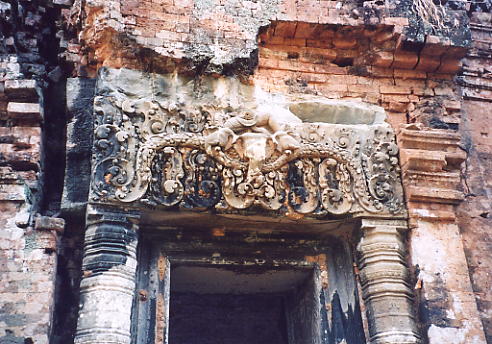 and sanitized by comparison to previous trips.
Retracing our route along the main road, we branched off
eastwards on what turned out to be a loop around the large
water-filled baray, rejoining the new road near the entrance to
Prasat Thom, the principal monument of the Koh Ker group. Our
first stop on the branch road was at a single brick tower called
Prasat Kraham. Just the track to the temple and a circle of
twenty metres surrounding the structure had been cleared of
landmines, with the red skull and bones signs clearly warning
visitors to venture no further into the forest. The
and sanitized by comparison to previous trips.
Retracing our route along the main road, we branched off
eastwards on what turned out to be a loop around the large
water-filled baray, rejoining the new road near the entrance to
Prasat Thom, the principal monument of the Koh Ker group. Our
first stop on the branch road was at a single brick tower called
Prasat Kraham. Just the track to the temple and a circle of
twenty metres surrounding the structure had been cleared of
landmines, with the red skull and bones signs clearly warning
visitors to venture no further into the forest. The 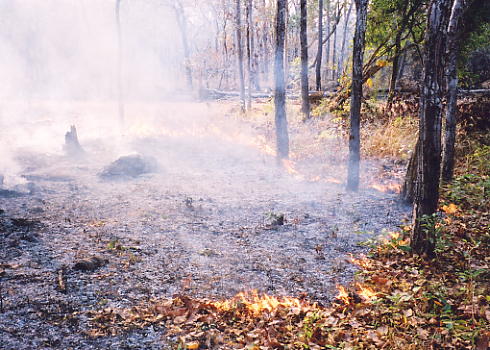 brick tower was in
reasonable condition, with two carved colonettes and an
unfinished lintel above the main entrance doorway. Two hundred
metres further on we came upon an unusual looking structure,
surrounded by large natural sandstone slabs. The temple,
brick tower was in
reasonable condition, with two carved colonettes and an
unfinished lintel above the main entrance doorway. Two hundred
metres further on we came upon an unusual looking structure,
surrounded by large natural sandstone slabs. The temple, 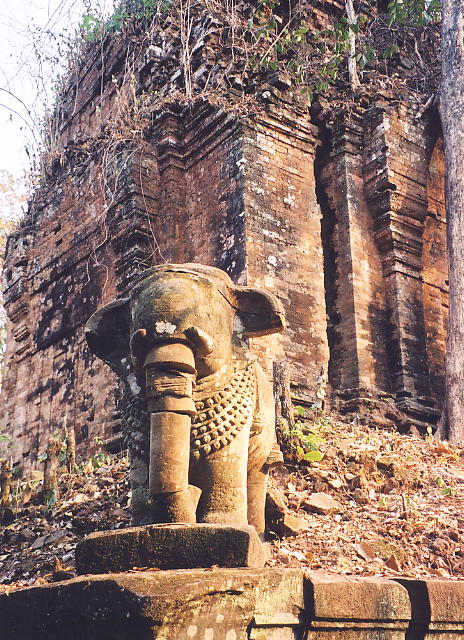 Prasat Khna, was built with the stone that was all
around us but it was partly demolished with no obvious
decoration. Half a kilometre away were two temples in close
proximity to each other, the largest being Prasat Damrei, the
smaller, Prasat Khlum. It was 3.30pm when we walked through a gap
in the laterite wall around Prasat Damrei. The large brick tower
is sat on a massive sandstone base, with two ruined brick
libraries closeby. Still in situ are two damaged sandstone
elephants, of the original four, one of which was almost
completely intact, the other had lost its head, next to a couple
of broken lion statues and an attractive lintel above the main
doorway, minus its vandalized central figure. The smaller
laterite tower nearby still housed two colonettes, an eroded
lintel and the remains of a small lion statue. These and four of
the next five temples were all new to me as I'd not encountered
them previously. What I didn't know was that I'd walked past a
Koh Ker gem - a collection of small lingas and figures, both gods
and female dieties, carved on a rockface and known as Ang Khna -
which I found out about once I'd returned home when a friend of
mine sent me a photo of the carvings.
Prasat Khna, was built with the stone that was all
around us but it was partly demolished with no obvious
decoration. Half a kilometre away were two temples in close
proximity to each other, the largest being Prasat Damrei, the
smaller, Prasat Khlum. It was 3.30pm when we walked through a gap
in the laterite wall around Prasat Damrei. The large brick tower
is sat on a massive sandstone base, with two ruined brick
libraries closeby. Still in situ are two damaged sandstone
elephants, of the original four, one of which was almost
completely intact, the other had lost its head, next to a couple
of broken lion statues and an attractive lintel above the main
doorway, minus its vandalized central figure. The smaller
laterite tower nearby still housed two colonettes, an eroded
lintel and the remains of a small lion statue. These and four of
the next five temples were all new to me as I'd not encountered
them previously. What I didn't know was that I'd walked past a
Koh Ker gem - a collection of small lingas and figures, both gods
and female dieties, carved on a rockface and known as Ang Khna -
which I found out about once I'd returned home when a friend of
mine sent me a photo of the carvings.
Continuing along the loop
road, some small brush fires were burning off the undergrowth
amongst the trees when we arrived at a large temple site, Prasat
Chrap. The entrance to the temple was ablaze so I had to jump
through a ring of fire and smoke to gain access through the two
laterite enclosure walls. This large complex 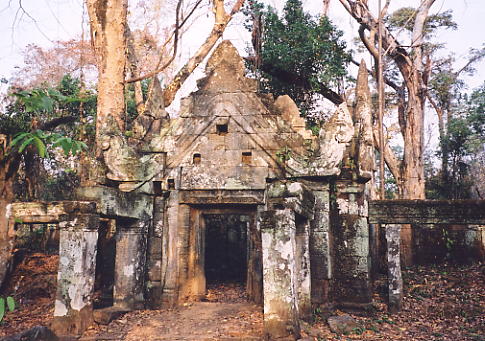 houses three tall laterite towers, similar in style
to Prasat Chen, alongwith two libraries, one brick and one
sandstone and laterite mix. The temple's lintels were conspicuous
by their absence and the only decorative features I could find
were some broken colonettes and a damaged lion statue amongst the
scorched earth. 'Danger!! Mines!!' signs were posted onto tree
trunks on the way to the next temple, Prasat Banteay Pir Chan.
Once again, the temple layout included two laterite walls, the
inner wall with a
houses three tall laterite towers, similar in style
to Prasat Chen, alongwith two libraries, one brick and one
sandstone and laterite mix. The temple's lintels were conspicuous
by their absence and the only decorative features I could find
were some broken colonettes and a damaged lion statue amongst the
scorched earth. 'Danger!! Mines!!' signs were posted onto tree
trunks on the way to the next temple, Prasat Banteay Pir Chan.
Once again, the temple layout included two laterite walls, the
inner wall with a 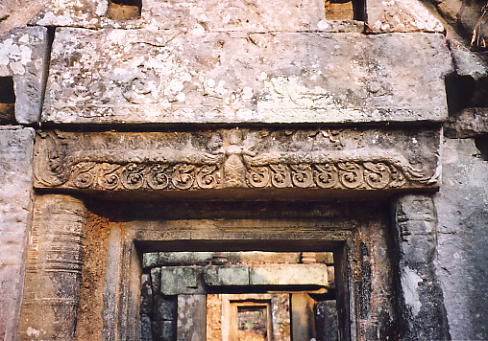 semi-intact entrance gopura with carved triangular
pediments and lintels, leading to one large central laterite
tower and five smaller brick towers (originally there were
eight), with sandstone doorframes and one damaged lintel
remaining in situ. A few hundred metres away, Prasat 'D' (we
could find no-one to confirm the name of this structure) is a
temple with a ramshackle entrance gopura leading onto two
completely ruined sandstone towers, guarded by ferocious red ants
determined to keep their
semi-intact entrance gopura with carved triangular
pediments and lintels, leading to one large central laterite
tower and five smaller brick towers (originally there were
eight), with sandstone doorframes and one damaged lintel
remaining in situ. A few hundred metres away, Prasat 'D' (we
could find no-one to confirm the name of this structure) is a
temple with a ramshackle entrance gopura leading onto two
completely ruined sandstone towers, guarded by ferocious red ants
determined to keep their 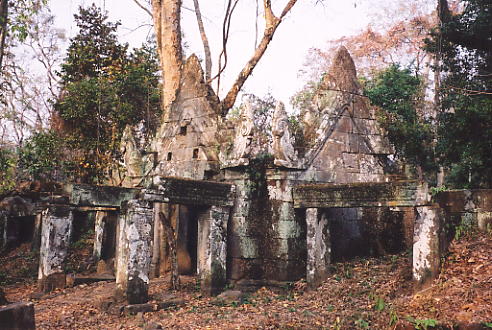 temple a secret. Nearby
was a temple I had visited before, Prasat Krachap (also known as
Kong Yuan), with two enclosure walls and an entrance that
reminded me of Banteay Srei at Angkor. Decorative lintels, gabled
roofs and superbly carved triangular pediments, two doorway
inscriptions (which date the temple to 928AD) and five brick
sanctuaries make this one of the more interesting temples at the
temple a secret. Nearby
was a temple I had visited before, Prasat Krachap (also known as
Kong Yuan), with two enclosure walls and an entrance that
reminded me of Banteay Srei at Angkor. Decorative lintels, gabled
roofs and superbly carved triangular pediments, two doorway
inscriptions (which date the temple to 928AD) and five brick
sanctuaries make this one of the more interesting temples at the 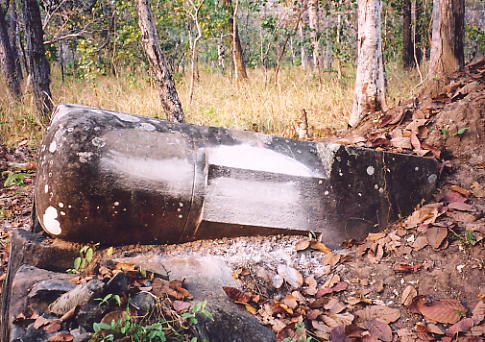 complex. The final
temple that I'd not previously seen was 100 metres further north
and was a small laterite enclosure with a wall and a library
though lacking decoration. This was Prasat Andong Kuk. In the
undergrowth, ten metres behind the temple was what I call the
'bomb' linga (Prasat Leung 4) lying on a pile of stones - an
elongated linga made of dark sandstone with the graffiti visible
on my last visit, now scrubbed off. In close proximity were the
other three large and identical square towers, made of uneven
sandstone blocks, each housing a gigantic linga on top of a
finely carved pedestal, without doubt the largest linga's I've
ever seen in Cambodia and a remarkable example of the Koh Ker
legacy in Khmer history. Prasat Leung 3 has a large chunk at the
base of the linga missing, Prasat Leung 2 has a totally intact
linga, whilst Prasat Leung 1's linga is slightly damaged though
its pedestal is the best preserved. None of the towers have their
roofs intact.
complex. The final
temple that I'd not previously seen was 100 metres further north
and was a small laterite enclosure with a wall and a library
though lacking decoration. This was Prasat Andong Kuk. In the
undergrowth, ten metres behind the temple was what I call the
'bomb' linga (Prasat Leung 4) lying on a pile of stones - an
elongated linga made of dark sandstone with the graffiti visible
on my last visit, now scrubbed off. In close proximity were the
other three large and identical square towers, made of uneven
sandstone blocks, each housing a gigantic linga on top of a
finely carved pedestal, without doubt the largest linga's I've
ever seen in Cambodia and a remarkable example of the Koh Ker
legacy in Khmer history. Prasat Leung 3 has a large chunk at the
base of the linga missing, Prasat Leung 2 has a totally intact
linga, whilst Prasat Leung 1's linga is slightly damaged though
its pedestal is the best preserved. None of the towers have their
roofs intact.
The loop road rejoins the main
road next to the entance gopura to Prasat Thom. This is the
largest complex in the whole group and includes Prasat Kraham and
the incredible seven-tiered pyramid temple of Prasat Thom itself.
We stopped for a chat with the two girls who'd set up drink
stalls under a large tree immediately in front of the gopura.
Both had bubbly personalities, though Lim spoke better English
and admitted she'd previously 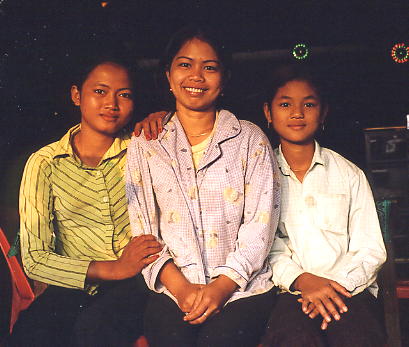 been a teacher in Siem
Reap but earnt more selling drinks at Koh Ker. Though trade was
slow at the moment, she fully expected it to pick up as more
tourists become aware of the treasures on show at Koh Ker. We
stopped for cold drinks and pineapple but decided against
climbing to the top of Prasat Thom again, as we'd done on
previous visits, as the sun had clouded over and a good quality
sunset was unlikely. Instead we headed back to our guesthouse at
Siyong, arriving just as dusk fell, and showered in the open air
at the water pump. Walking into the market area just fifty metres
from our guesthouse, the first restaurant had loud karaoke music
blaring out from the tv but didn't have any food, so we went next
door where we enjoyed three pork dishes and were served by the
adorable Lee,
been a teacher in Siem
Reap but earnt more selling drinks at Koh Ker. Though trade was
slow at the moment, she fully expected it to pick up as more
tourists become aware of the treasures on show at Koh Ker. We
stopped for cold drinks and pineapple but decided against
climbing to the top of Prasat Thom again, as we'd done on
previous visits, as the sun had clouded over and a good quality
sunset was unlikely. Instead we headed back to our guesthouse at
Siyong, arriving just as dusk fell, and showered in the open air
at the water pump. Walking into the market area just fifty metres
from our guesthouse, the first restaurant had loud karaoke music
blaring out from the tv but didn't have any food, so we went next
door where we enjoyed three pork dishes and were served by the
adorable Lee, 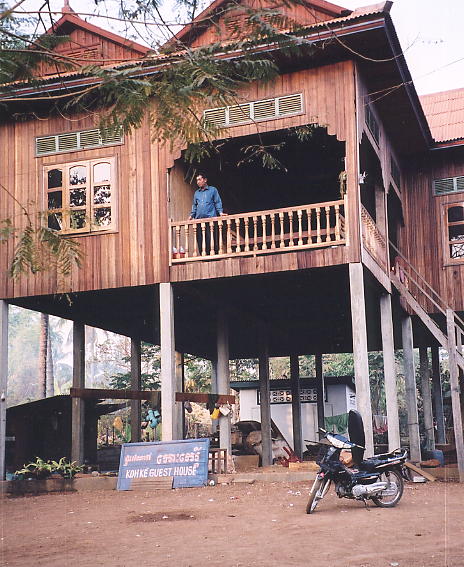 who had an abundance of natural beauty and a radiant
smile, and Srey and Chadi. Nineteen year old Lee was the niece of
the restaurant owner and had recently arrived to help with
cooking and waitress duties. She didn't speak any English but her
beaming smile and graceful demeanour was enough to light up any
conversation. By the time we'd finished our meal at a little
before 8pm, most of the village had turned in for the night, so
we returned to the guesthouse for a chat with the owners before
turning in ourselves at 9pm. I enjoyed a pleasant sleep, courtesy
of a comfortable wooden bed and mattress, pillows and a mozzie
net provided by the owners, despite the best efforts of an
amalgam of dogs fighting, cocks crowing and pigs snorting
throughout the night. Up at 6.30am the next morning, we returned
to the restaurant for some hot beef noodles and coffee and to say
goodbye to the lovely Lee and her hospitable family before
leaving Siyong at 7.30am for our long moto-ride to the far north
and a return visit to the dramatic mountain-top temple of Prasat
Preah Vihear.
who had an abundance of natural beauty and a radiant
smile, and Srey and Chadi. Nineteen year old Lee was the niece of
the restaurant owner and had recently arrived to help with
cooking and waitress duties. She didn't speak any English but her
beaming smile and graceful demeanour was enough to light up any
conversation. By the time we'd finished our meal at a little
before 8pm, most of the village had turned in for the night, so
we returned to the guesthouse for a chat with the owners before
turning in ourselves at 9pm. I enjoyed a pleasant sleep, courtesy
of a comfortable wooden bed and mattress, pillows and a mozzie
net provided by the owners, despite the best efforts of an
amalgam of dogs fighting, cocks crowing and pigs snorting
throughout the night. Up at 6.30am the next morning, we returned
to the restaurant for some hot beef noodles and coffee and to say
goodbye to the lovely Lee and her hospitable family before
leaving Siyong at 7.30am for our long moto-ride to the far north
and a return visit to the dramatic mountain-top temple of Prasat
Preah Vihear.
Here's links to the rest of my Cambodia Tales
January 2005 marked my eleventh trip to Cambodia since my first-ever visit in 1994. It's a country that has a special magic all of its own and which draws me back every year to venture out into the Cambodian countryside in search of new adventures, ancient temples and to catch up with the friends I've made from previous visits. Each trip is full of laughter, smiles and a host of fresh experiences and my latest expedition was no exception.
Home : Next : Messageboard : 2005 : E-mail
The contents of this website cannot be reproduced or copied without permission of the site author. (c) Andy Brouwer 2005
Click to enlarge all photos. Click 'refresh' if photos do not fully load.